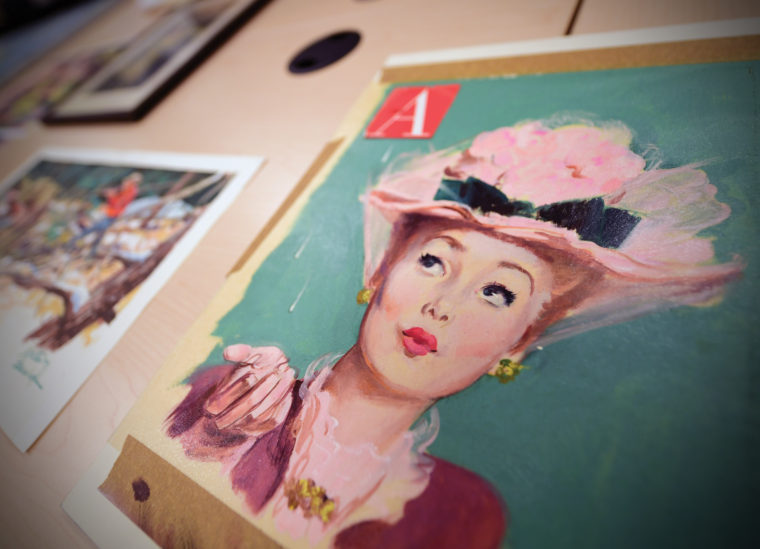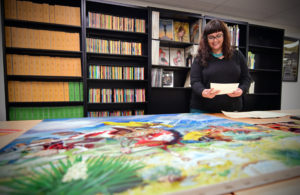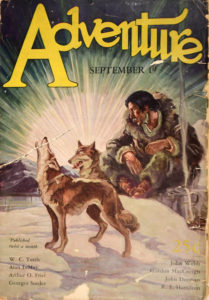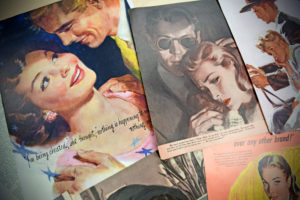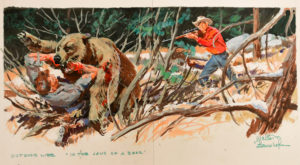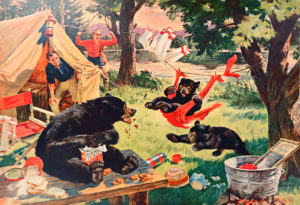Before there was the “King of Pop,” there was the “King of the Pulps.” Perhaps not as well known as Michael Jackson, Walter Baumhofer held a significant place in American 20th-century culture as a magazine illustrator. During his long career, he crossed genres, moving successfully from low-paying pulp fiction covers (producing some 550) to mainstream magazines, called “slicks.”
The university’s Modern Graphic History Library recently received a collection of Baumhofer’s work, including original art, publications, reference materials and supporting documents that add context to his work and the field of commercial illustration. Here, the magazine editor talks with Skye Lacerte, curator of the Modern Graphic History Library, about the recent acquisition and its importance.
-
How did you acquire the Walter Baumhofer collection?
A prominent illustration dealer and appraiser acted on behalf of the late Walter Baumhofer’s sister-in-law, who was looking to donate the collection to an educational institution. The appraiser got in touch with us, and we enthusiastically accepted.
-
Why is the collection important in historical terms?
Walter Baumhofer was known not only as the King of Pulps, but also as one of the few artists who successfully achieved the move from illustrating for low-paying pulp fiction to what is called the “slicks,” mainstream magazines like American magazine, Adventure, Detective Tales and Ladies Home Journal. His illustrations played a significant role both in influencing and in reflecting contemporary life. The collection includes sketches, original art, tear sheets, publications, reference materials and supporting documents that add context to his work and the field of commercial illustration. It also includes some of his work from his later years. A lot of illustrators later in life, when photography became more prominent in periodicals, started just painting and selling their works, mostly Western style.
-
How does it compare with other major acquisitions at the Modern Graphic History Library?
The MGHL contains dozens of collections representing some of the most significant figures in graphic media, past and present. A particular focus of the MGHL is 20th-century illustration, including the archives of famous illustrators such as Al Parker, Robert Weaver, Robert Andrew Parker and others. One interesting thing about the Baumhofer collection is how it fits into our larger collection in that Baumhofer was a contemporary of Parker’s, who was a Washington University alum and who was the first illustrator’s work we acquired. Al Parker was known as the “rock star of illustration,” and he was prolific with women’s magazines and the more feminine side of illustration. And although Baumhofer illustrated for some ladies’ magazines, he was known primarily for adventure, rugged outdoor and men’s stuff. So it’s nice to have that contrast. In addition, the rich array of materials represented in the Baumhofer Collection will give us further insight into the professional and personal lives of these well-known magazine illustrators during a time when illustration was a significant and essential component of publishing.
-
What is the importance of the MGHL to the university?
Washington University Libraries’ top strategic priorities include facilitating seamless access to robust and distinctive collections to the university community.
The reason we collect and preserve periodical illustrations at the Modern Graphic History Library, in general, is because we believe that they are products of a commercial culture and that they not only reflect changing artistic styles and tastes, but also provide insight into American society and culture of the late-19th and 20th centuries. Unfortunately, illustration and illustrators have been left out of the annals of high visual culture nearly from the beginning of the profession until recently. Now, illustration is gaining more and more popularity among collectors, practitioners, historians and scholars.
Douglas B. Dowd*, the MGHL faculty director and professor of art and American culture studies, is leading a new Visual and Material Culture program that will launch an undergraduate minor and graduate certificate program in fall 2019. The program engages cultural, historical and aesthetic analyses of images and objects in mass culture and focuses on communities of production, reception and use. The materials in this collection will directly support curricula and faculty and student research for this program.
[*Of note, the Modern Graphic History Library will be dedicated as the Douglas B. Dowd Modern Graphic History Library, made by possible by an endowing gift from Ken and Nancy Kranzberg, Sept. 27, 2016. Click here for more information.)
-
How do students/faculty use the collections at the library?
The MGHL is located at West Campus and is open to the public (appointments recommended), Monday through Friday, 9 a.m.–5 p.m. Information can be found here.
— Terri Nappier is editor of this magazine.
